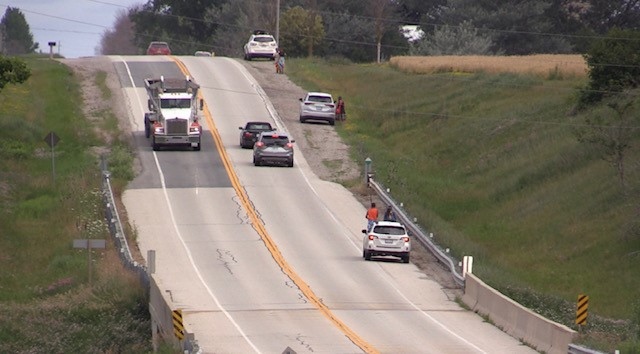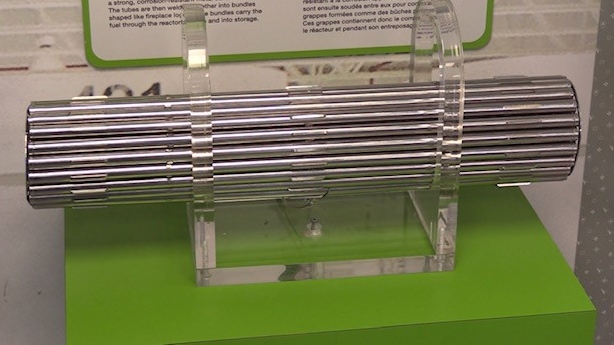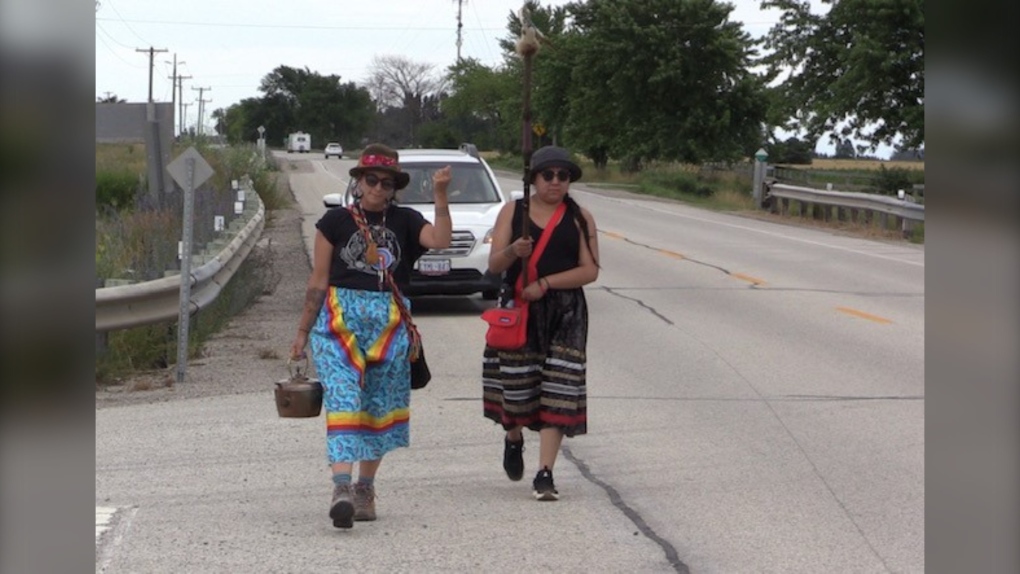Nuclear issues weigh heavily on Saugeen Ojibway water walkers
Benji Keeshig is proudly walking the entire boundary of the Saugeen Ojibway territory with his young daughters. One by his side, the other on his shoulders.
“It gets heavy some times, but they’ll know that, when I’m good and gone, that we walked our whole entire territory with their daddy, you know,” said Keeshig.
The Keeshigs aren’t alone.
Over the course of July, nearly a hundred members of the Saugeen Ojibway Nation (SON) will share the millions of steps required to traverse the entire boundary of their territory, from Tobermory in the north, south to Goderich, east to Arthur, and back up to Collingwood.
They’ll be carrying a kettle of life-giving water and an eagle staff, as the nearly 5,000 members of SON grapple with ‘forever’ decisions regarding massive energy and nuclear waste projects proposed for their territory.
 Walkers take part in the Saugeen Ojibway Nation water walk that covers the 600 kilometre boundary of the Saugeen Ojibway territory that stretches from Tobermory to Goderich, east to Arthur, and north to Collingwood. (Scott Miller/CTV News London)
Walkers take part in the Saugeen Ojibway Nation water walk that covers the 600 kilometre boundary of the Saugeen Ojibway territory that stretches from Tobermory to Goderich, east to Arthur, and north to Collingwood. (Scott Miller/CTV News London)
“High level nuclear waste, low and intermediate level nuclear waste. We have pits and quarries. We have the proposed pumped storage project near Meaford that is also in our territory,” said SON water walk team member, Joanne Helena Keeshig, also known as, Bzauniibi Kwe.
Keeshig said the water walk is a cultural expression to give prayer to the land and water, and with so many ‘forever’ projects potentially impacting the land and water in their territory, now is the time to reconnect with what really matters.
“Encouraging people to come out and make their own personal connection with the earth, to be able to find out what are the answers we’re looking for. How do we do that, because we have to? We know, just with the nuclear waste issue, that is something that will never be resolved in our lifetime. So, how do we generate interest and concern in the young people, to be able to pick that up, and be vigilant on those issues,” explained Keeshig.
 Example of used nuclear fuel bundle in Teeswater from March 2019. (Scott Miller / CTV News)
Example of used nuclear fuel bundle in Teeswater from March 2019. (Scott Miller / CTV News)
Making that personal connection is exactly what brought Janis Rain Migwans and Katrina Keeshig to Wednesday’s section of the water walk, north of Goderich, Ont.
“I always knew I had some connection to the water. I didn’t know what the connection was. That’s kind of what I’m trying to do. I’m trying to learn what I can do for the water,” said Migwans.
“Our First Nations’ are facing a lot of really big decisions, so this water walk is symbolic and necessary to understand the territory, the size of it, and the pressures it is facing,” said Keeshig.
 Janis Rain Migwans and Katrina Keeshig, seen in Goderich, Ont. on July 12, 2023, take part in the Saugeen Ojibway Nation water walk that is covering the 600 kilometer boundary of the Saugeen Ojibway territory, stretching from Tobermory to Goderich, east to Arthur, and north to Collingwood. (Scott Miller/CTV News London)
Janis Rain Migwans and Katrina Keeshig, seen in Goderich, Ont. on July 12, 2023, take part in the Saugeen Ojibway Nation water walk that is covering the 600 kilometer boundary of the Saugeen Ojibway territory, stretching from Tobermory to Goderich, east to Arthur, and north to Collingwood. (Scott Miller/CTV News London)
SON members are about half way through their 600 kilometre water walk from Meaford to Arthur, Goderich, Tobermory, and back to Meaford again.
On their minds, with each step, are impending decisions their community will make on whether to allow all of Canada’s high level nuclear waste to be permanently stored in their territory or not.
“This whole territory, it needs to be protected. And if nobody is going to do it, then it falls on us, and this will be their job [pointing to his children] when we’re all gone,” said Keeshig as he carried his youngest daughter on his shoulders, while he walks the entirety of the Saugeen Ojibway territory — his homeland.
CTVNews.ca Top Stories

Prime Minister Trudeau meets Donald Trump at Mar-a-Lago
Prime Minister Justin Trudeau landed in West Palm Beach, Fla., on Friday evening to meet with U.S.-president elect Donald Trump at Mar-a-Lago, sources confirm to CTV News.
'Mayday! Mayday! Mayday!': Details emerge in Boeing 737 incident at Montreal airport
New details suggest that there were communication issues between the pilots of a charter flight and the control tower at Montreal's Mirabel airport when a Boeing 737 made an emergency landing on Wednesday.
Hit man offered $100,000 to kill Montreal crime reporter covering his trial
Political leaders and press freedom groups on Friday were left shell-shocked after Montreal news outlet La Presse revealed that a hit man had offered $100,000 to have one of its crime reporters assassinated.
Questrade lays off undisclosed number of employees
Questrade Financial Group Inc. says it has laid off an undisclosed number of employees to better fit its business strategy.
Cucumbers sold in Ontario, other provinces recalled over possible salmonella contamination
A U.S. company is recalling cucumbers sold in Ontario and other Canadian provinces due to possible salmonella contamination.
Billboard apologizes to Taylor Swift for video snafu
Billboard put together a video of some of Swift's achievements and used a clip from Kanye West's music video for the song 'Famous.'
Musk joins Trump and family for Thanksgiving at Mar-a-Lago
Elon Musk had a seat at the family table for Thanksgiving dinner at Mar-a-Lago, joining President-elect Donald Trump, Melania Trump and their 18-year-old son.
John Herdman resigns as head coach of Toronto FC
John Herdman, embroiled in the drone-spying scandal that has dogged Canada Soccer, has resigned as coach of Toronto FC.
Weekend weather: Parts of Canada could see up to 50 centimetres of snow, wind chills of -40
Winter is less than a month away, but parts of Canada are already projected to see winter-like weather.


































